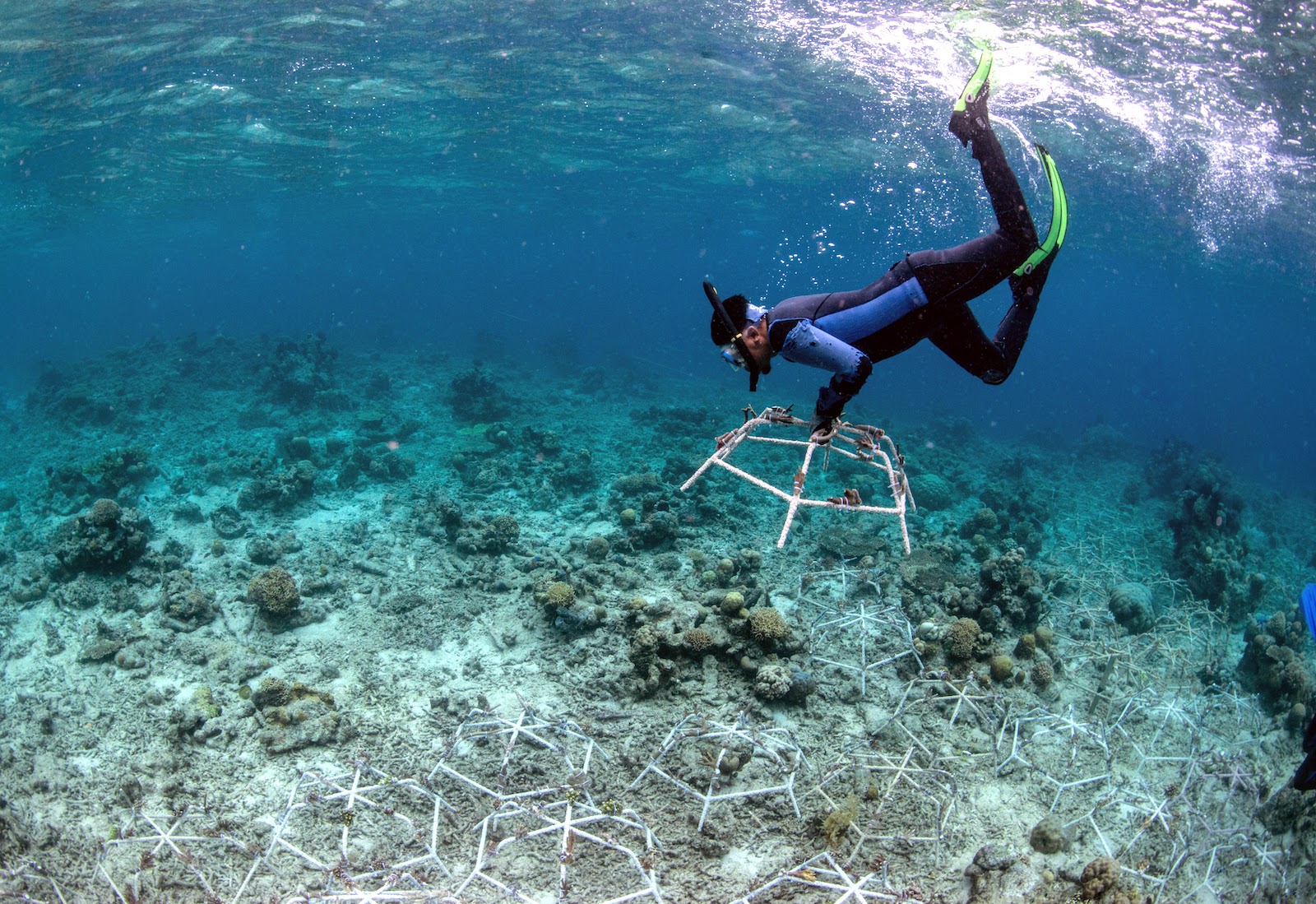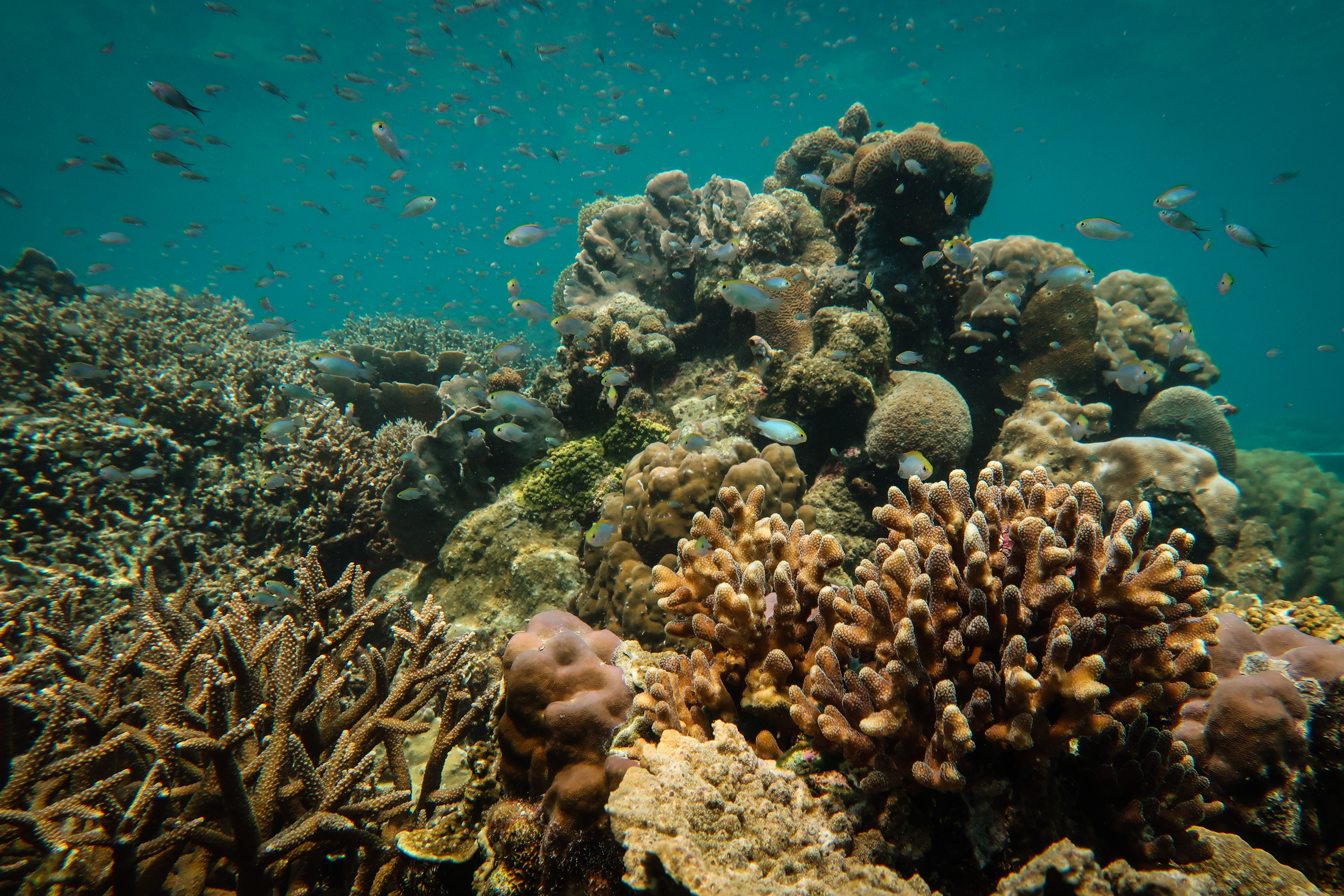Out among a scattering of islands spilled like beads into the Indonesian shallows, an extended experiment in coral restoration has revealed something marvelous: With a tender touch and a community to care for it, a reef can fully recover from the devastation of blast fishing in just four years.
The Spermonde Archipelago, which lies a dozen miles off the coast of South Sulawesi, Indonesia, was long home to some of the most dynamic reefs in the world, where schools of fish rainbowed over coral blanketing the seafloor. But dynamite fishing turned swaths of those wonders into wastes. That was, until, in 2018, when academics, government agencies, nonprofits, and local communities came together to restore them with a novel approach developed over years of testing and refinement. Now, a team of marine biologists and reef ecologists has released the first results in a suite of studies investigating the program’s achievements. The study, published earlier this month in Current Biology, shows that the method can help reefs rebuild in just a few years.
“We do always refer to corals, in particular in reefs, as these slow growing ecosystems that take a long time to recover, which they are,” said Rebecca Albright, a coral biologist at the California Academy of the Sciences who was not involved in the study. “So showing that they can regain rapid growth within four years is very encouraging.”
Promoting this recovery in Sulawesi is particularly important because the island sits at the center of the Indonesian archipelago, and in one corner of the Coral Triangle. This region, and Indonesia in particular, is home to the largest concentration of reefs and coral habitat in the world. Yet, many of these vibrant ecosystems were pulverized by decades of fishers dropping explosives into the water to concuss fish they could then scoop out of the sea. With loose rubble then left to tumble in the currents, corals had little hope of recovering on their own. Any coral spawns that might settle and grow were liable to be crushed by errant rocks.
To overcome this, the Mars Coral Reef Restoration Program – a nonprofit funded by the Mars corporation known for M&Ms, Twix, and Snickers – brought together restoration experts who developed what they call the reef star: a six-legged steel spider coated in sand, to which coral fragments harvested from nearby healthy reefs or found rolling with the tides are strapped. Restoration workers, often members of local communities, deploy them across dozens of sites. These webs provide the protection and stability the transplants need to grow, while also settling the debris created by blast fishing. Without such help, researchers believe that corals – those strange yet essential sea creatures – might never have returned to the damaged areas.
Within a year of placing the reef stars, the fragments grew into colonies. By year two, the branches of neighboring colonies knit into a marine embrace. By 2023, the former fragments had grown into orange bushels, broad yellow pads, and twisting pink tentacles that trains of fluorescent fish explore.

The Ocean Agency
Scientific analysis confirmed what the eye could see. By measuring something called a carbonate budget – a way of understanding how well a colony can grow its limestone skeleton in the face of erosive forces like fish, divers, and passing vessels – researchers found that the rate of growth for sites established just four years before matched that of healthy, undamaged coral growing nearby.
Studying this growth helps scientists to understand how well a reef fulfills its role as the star of a healthy ecosystem providing habitat for marine life. “The 3-D structure of the reef is basically the city where these animals live,” said Ines Lange, a coral reef ecologist and lead author of the paper. “So, providing an actively growing three-dimensional structure is the basis for this whole ecosystem.”
The rate and state of growth also reveals whether the reef can be expected to once again protect coastlines from storm surges and coastal erosion — and grow quickly enough to keep up with rising seas to continue doing that. The results show that won’t be a problem around South Sulawesi. Other restoration efforts, like those in the Florida Keys, tend to string up a few strands of coral fragments or pepper the seafloor with them in a way that felt, for Lange, “like a little tiny garden.” But, at the Mars program sites, “It’s like they put a forest there.”
“I think it was the first time I saw a restoration site that was a proper reef,” she said.
These sea groves are populated primarily by branching, arborescent coral sprouting from the reef star arrays in the coastal shallows. They’ve created a terrain flourishing with life that turns the aquamarine waters into a technicolor dreamscape. Overall, the method has proven itself even to those watching it unfold from afar.
“The Mars project has set the bar really high for how you can do evidence-based reef restoration,” said Lisa Bostrom-Einarsson, a coral reef ecologist with the University of Exeter.
Though not affiliated with the study, Bostrom-Einarsson has collaborated with two of its authors on a previous paper. Unsurprisingly, the world of coral reef conservation remains small, despite the great need for its work.
Four years ago, Bostrom-Einnarsson compiled a systematic and comprehensive review of reef restoration projects, which she is in the process of updating based on the progress made in such efforts globally in the intervening years. That background led her to conclude, after reading Lange’s paper, that “it’s a gold standard study on a gold standard project.”

Ines Lange
Still, Mars’ reef stars are suited best to sites like South Sulawesi where the trauma is physical. When reefs have been broken by widespread blast fishing or gored by ship groundings – of which there are hundreds every year – the study shows the devices can help heal those injuries with startling ease. But in areas like the Great Barrier Reef marred by recurrent bleaching events that offer little of the reprieve reefs need to recover, they can only do so much; the repeated heat waves spurred by elevated temperatures make the water itself hostile to coral. Nonetheless, the Mars program launched an effort late last year to adapt its approach for Australia’s iconic reef. The kinds of coral most sensitive to warming are also those best fit for the Mars method.
In the waters of South Sulawesi, the restoration team favored branching corals both because they make up the bulk of the healthy reefs in the region and because they grow quickly — Bostrom-Einarsson called them “weedy coral.” But the tree-like Acropora can’t stand the heat the way their massive, slow-growing cousins the brain coral can; Acropora are among the first to bleach when temperatures climb. So, while the marine meadows at the restoration sites have prospered in recent years, more remains to be done to make them resilient to warming seas.
“You can put a bunch of coral back out into place, but that doesn’t mean you’re building a resilient reef,” Albright said. “You have to have diversity.”
Lange said the Mars program is bolstering the ecosystems’ resilience, transplanting massive corals and providing the surfaces they need to establish, settle, and mature. This is just one area that reflects the responsive approach Bostrom-Einarrson said the Mars program has brought to its efforts by listening to scientists, considering their evidence, and tapping their expertise.
But to avoid what Bostrom-Einarrson called “scientific colonialism” – in which researchers from well-funded institutions visit under-resourced areas to collect data before scurrying home – the Mars program has built partnerships with local communities and universities. They are involved in everything from building the reef stars and installing them to maintaining and monitoring restoration sites, all of which gives them a sense of ownership over the project by making them guardians of the reefs.
And that may be one of the most important outcomes of a project like this. After all, coastal communities in places like South Sulawesi benefit most from rebuilding the reefs that protect them from the storms and surging seas that climate change brings. But the researchers acknowledged that restoration efforts like these are but band aids. They aren’t a substitute for abating emissions and mitigating climate change so reefs can escape the endless onslaught of bleach-inducing, coral-killing heat waves.
“We’re not saying we can repair all the coral reefs in the world with this method,” Lange said. “But that doesn’t mean we shouldn’t do something on the scale that we can to change something for a local community, because it makes a huge difference for them.”
So, if for that reason alone, these efforts matter – even in the wake of a warming world.
This story was originally published by Grist with the headline ‘Reef stars’ restored Indonesia’s blast-damaged corals in just 4 years on Mar 26, 2024.

